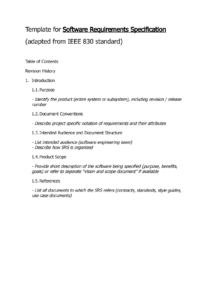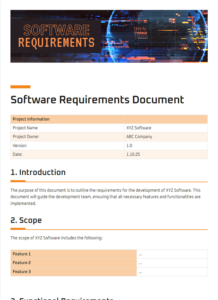Defining the requirements for a software project is a critical step that sets the foundation for its success. A well-defined set of requirements ensures that the software meets the business needs and addresses user expectations. To streamline this process, many businesses rely on software business requirements templates.
Importance of a Software Business Requirements Template
A software business requirements template provides a structured framework for gathering, organizing, and documenting the requirements. It ensures that all essential aspects of the software are considered, including functionality, performance, security, and usability. By using a template, businesses can reduce the risk of missed requirements, misinterpretations, and scope creep.
Moreover, a template helps stakeholders collaborate effectively by providing a common language and understanding of the requirements. It facilitates communication between business analysts, developers, testers, and end-users, ensuring that everyone is working towards the same goal. The template also serves as a reference point for future maintenance and enhancements, ensuring the software remains aligned with business objectives.
Elements of a Comprehensive Software Business Requirements Template
Functional Requirements
Functional requirements define the specific tasks and functions that the software must perform. They describe the behavior of the system in response to user actions and external stimuli. Functional requirements should be detailed, unambiguous, and testable to ensure that the software meets the intended use cases.
For example, a functional requirement for an e-commerce website might state that “The website must allow users to search for products by category, name, or description and display the results in a list format sorted by relevance.”
Non-Functional Requirements
Non-functional requirements focus on the overall qualities and characteristics of the software, such as performance, security, reliability, and usability. They define the constraints and limitations that the software must adhere to.
Examples of non-functional requirements include:
– The software must be able to handle 10,000 concurrent users.
– The software must meet industry-standard security protocols.
– The software must have an intuitive and user-friendly interface.
Technical Requirements
Technical requirements describe the specific technologies and platforms that the software must use. They ensure that the software is compatible with the existing infrastructure and adheres to any architectural constraints.
Technical requirements may include:
– The software must be developed using Java programming language.
– The software must be deployed on a Linux operating system.
– The software must integrate with a third-party database.
Conclusion
A software business requirements template is an essential tool for capturing and documenting the needs of a software project. By providing a structured framework and guiding stakeholders towards a common understanding of the requirements, a template helps ensure the successful development of software that meets business objectives.
Choosing the right template is crucial for effectiveness. Businesses should consider their specific project needs, the size and complexity of the software, and the regulatory or industry standards applicable to the project. By selecting and using a comprehensive software business requirements template, businesses can lay the groundwork for a successful software development journey.


